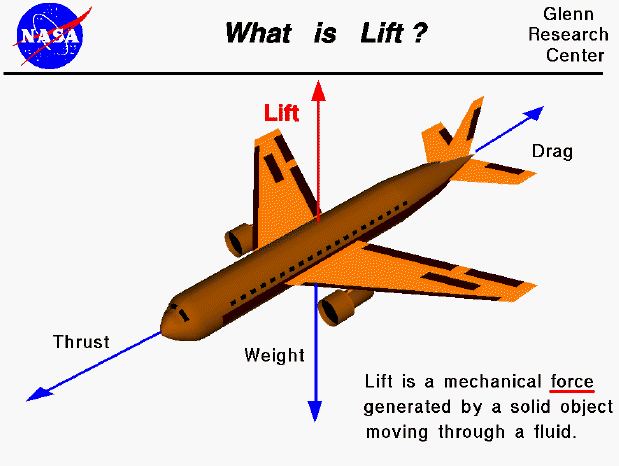

Lift is the force that holds an aircraft in the air. Lift can be generated by any part of the airplane, but most of the lift on a normal airliner is generated by the wings. Lift is an aerodynamic force produced by the motion of a fluid past an object. Lift acts through the center of pressure of the object and is defined to be perpendicular to the flow direction.
HOW IS LIFT GENERATED?
There are many explanations for the generation of lift found in encyclopedias, in basic physics textbooks, and on Web sites. Unfortunately, many of the explanations are misleading and incorrect. Theories on the generation of lift have become a source of great controversy and a topic for heated arguments. To help you understand lift and it's origins, a series of pages will describe the various theories and how some of the popular theories fail.
Lift occurs when a flow of gas is turned by a solid object. The flow is turned in one direction, and the lift is generated in the opposite direction, according to Newton's Third Law of action and reaction. Because air is a gas and the molecules are free to move about, any solid surface can deflect a flow. For an airfoil, both the upper and lower surfaces contribute to the flow turning. Neglecting the upper surface's part in turning the flow leads to an incorrect theory of lift.
NO FLUID, NO LIFT
Lift is a mechanical force. It is generated by the interaction and contact of a solid body with a fluid (liquid or gas). It is not generated by a force field, in the sense of a gravitational field,or an electromagnetic field, where one object can affect another object without being in physical contact. For lift to be generated, the solid body must be in contact with the fluid: no fluid, no lift. [The space shuttle does not stay in space because of lift from its wings but because of orbital mechanics related to its speed. Space is (nearly) a vacuum. Without air, there is no lift generated by the wings.]
NO MOTION, NO LIFT
Lift is generated by the difference in velocity between the solid object and the fluid. There must be motion between the object and the fluid: no motion, no lift. It makes no difference whether the object moves through a static fluid, or the fluid moves past a static solid object. Lift acts perpendicular to the motion. (Drag acts in the direction opposed to the motion.)
You can learn more about the factors that affect lift at this web site. There are many small interactive programs here to let you explore the generation of lift.
Navigation ..
Navigation..
Go to...
byTom
Benson
Please send suggestions/corrections to: benson@grc.nasa.gov